Prostate Cancer
Prostate cancer is the most common cancer among men Prostate cancers usually grow slowly. Most men with prostate cancer are older than 65 years and do not die from the disease.
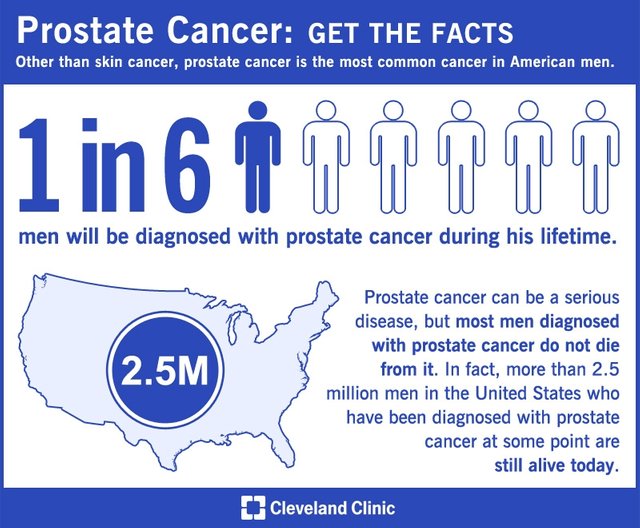
Image source: Cleveland Clinic
What is the prostate?
The prostate is an exocrine gland of the male reproductive system, and exists under the bladder, in front of the rectum. It is approximately the size of a walnut. As the urethra goes through the prostate: the prostate gland is also involved in urine control.
The function of the prostate is to secrete a slightly alkaline fluid, milky in appearance, that in humans usually constitutes roughly 30% of the volume of the semen along with spermatozoa and seminal vesicle fluid.
As a man ages, the prostate tends to increase in size. This can cause the urethra to narrow and decrease urine flow. This is called benign prostatic hyperplasia, and it is not the same as prostate cancer.
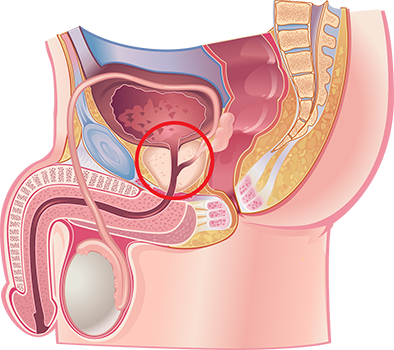
Image source: Prostaphane.com
What Are the Risk Factors for prostate cancer?
1.Age: The older a man
2.Family history: a man with a father, brother, or son who has had prostate cancer is two to three times more likely to develop the disease himself
3.Race: Prostate cancer is more common in African-American men
4.Diet: obesity leads to an increased risk of having a more aggressive, larger prostate cancer
5.Infection: Recent evidence has suggested the role of sexually transmitted infections as one of the causative factors for prostate cancer.
6.Cadmium:
7.Selenium and vitamin E: vitamin E not only fails to prevent prostate cancer but actually increases prostate cancer risk.
Image source: shutterstock.com
Factors not associated with prostate cancer:
1.Benign prostatic hyperplasia (BPH):
2.Vasectomy:
3.Sexual activity:
What Are the Symptoms of Prostate Cancer?
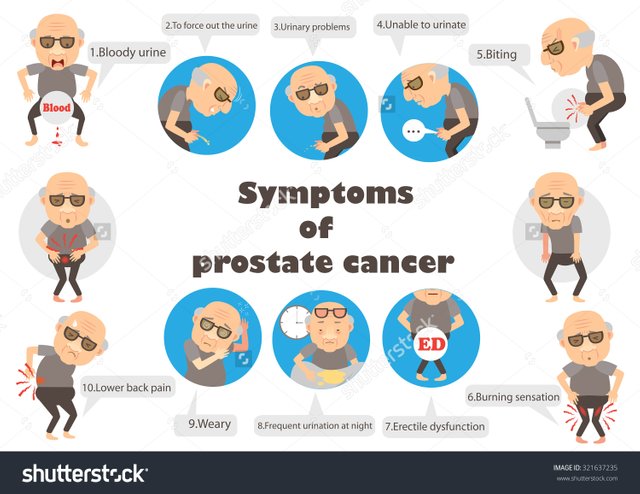
Image source: Shuttertock.com
Urinary symptoms of prostate cancer:
• Burning or pain during urination
• Difficulty urinating, or trouble starting and stopping while urinating
• More frequent urges to urinate at night
• Loss of bladder control
• Decreased flow or velocity of urine stream
• Blood in urine (hematuria)
Other prostate cancer signs & symptoms
• Blood in semen
• Difficulty getting an erection (erectile dysfunction)
• Painful ejaculation
• Swelling in legs or pelvic area
• Numbness or pain in the hips, legs or feet
• Bone pain that doesn't go away, or leads to fractures
Other sign & symptoms:
- Urinary tract infection (UTI)
- Bladder obstruction
- Acute kidney failure
- Deep bone pain, especially in the back, hips, or thighs, or bone fracture:
- Spinal cord compression
When Should you Call the Doctor about Prostate Cancer?
- Difficulty initiating and/or stopping a urine stream
- Frequent urination
- Pain on urination
- Pain on ejaculation
- Decreasing speed of urine flow or a urine stream that stops and starts
- A sensation of incomplete emptying of the bladder even after passing urine
- Erectile dysfunction
- Bone pain and/or fractures
Why is Prostate Cancer Screening Important?
Urologists recommend regular screening for prostate cancer using PSA and DRE in men who are likely to live more than 10 years of their life expectancy.
Elevated prostate serum antigen (PSA) it predicts the risk of prostate cancer being present.
Abnormal digital rectal exam (DRE): Prostate cancers may be suspected with an abnormal prostate exam detected by digital rectal exam (DRE).
Elevated prostate cancer antigen 3 (PCA3): PCA3 is new test that may help to discriminate between cancer-related versus nonspecific PSA elevations.
The American Urological Association (AUA) issued their latest guidelines for prostate cancer in 2013. According to these guidelines, men at the age of 55-69 should be offered a baseline serum PSA test and a prostate exam (DRE) to ascertain the risk of prostate cancer.
The following standards have been set for PSA levels:
Less than 4 ng/mL: Normal value.
4 to 10 ng/mL: Prostate biopsy is usually recommended for men
Greater than 10 ng/mL: Prostate biopsy is strongly recommended
A PSA of 4 ng/mL has been used as a cutoff value for deciding for or against doing a prostate biopsy.
Other blood test may include:
1.Complete blood cell count (CBC):
2.BUN( blood urea and nitrogen ) and creatinine:
3.Alkaline phosphatase:
Staging of prostate cancer
Staging is a system of classifying tumors by size, location, and extent of spread, local and remote. is also a good indicator of prognosis, or the chances of success after treatment
Stage I (or A): The cancer cannot be felt on digital rectal exam, and there is no evidence that it has spread outside the prostate. These are often found incidentally during surgery for an enlarged prostate.
Stage II (or B): The tumor is larger than a stage I and can be felt on digital rectal exam. There is no evidence that the cancer has spread outside the prostate. These are usually found on biopsy when a man has an elevated PSA level.
Stage III (or C): The cancer has invaded other tissues neighboring the prostate.
Stage IV (or D): The cancer has spread to lymph nodes or to other organs.
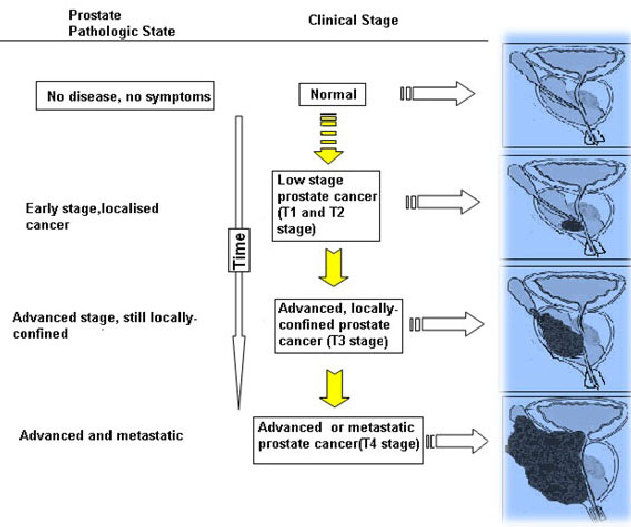
What are Treatments of Prostate Cancer?
Overview
Treatments for prostate cancer are generally effective in most men. Different treatment options are indicated depending on the severity of the disease.
Treatment for localized prostate cancer include:
1.Active surveillance
2.Radical prostatectomy
3.Radiation therapy
4.Cryotherapy and HIFU
Treatment for advanced disease includes:
1.Hormonal therapy
2.Chemotherapy
What is Radical Prostatectomy?
Radical prostatectomy is the surgical removal of the entire prostate. This operation is indicated for cancer that is limited to the prostate and has not invaded the capsule of the prostate, any other nearby structures or lymph nodes, or distant organs. These may include
Laparoscopic radical prostatectomy:
Robot-assisted radical prostatectomy (RARP):
Transurethral resection of the prostate (TURP) is an alternative to radical prostatectomy
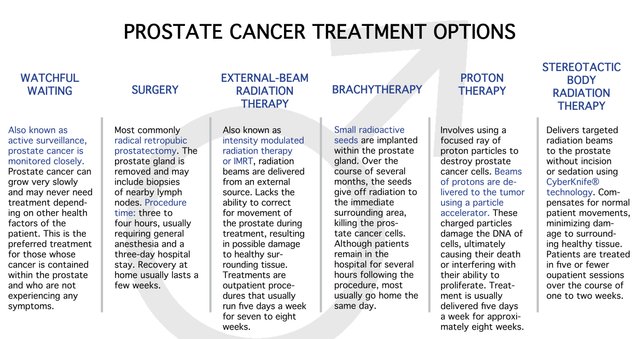
Image source: Phillycyberknife.com
References:
1.https://en.wikipedia.org/wiki/Prostate_cancer
2.https://en.wikipedia.org/wiki/Prostate
3.https://www.pcf.org/c/prostate-cancer-symptoms/
4.https://www.cdc.gov/cancer/prostate/basic_info/symptoms.htm
5.http://www.emedicinehealth.com/prostate_cancer
6.https://ghr.nlm.nih.gov/condition/prostate-cancer
very help full article Dr, I'm campaigning about cancer in my place to,thx for sharing
Thank you, very usefull.
There is not such a thing as too much health education.
Yes you are right.
https://steemit.com/health/@vox00/cancer-cells-cannot-live-in-alkaline-tissues